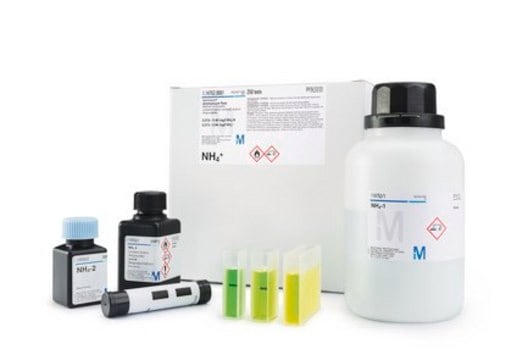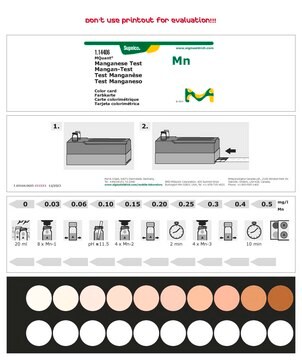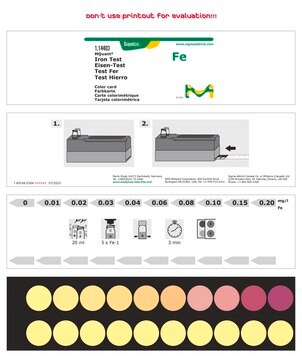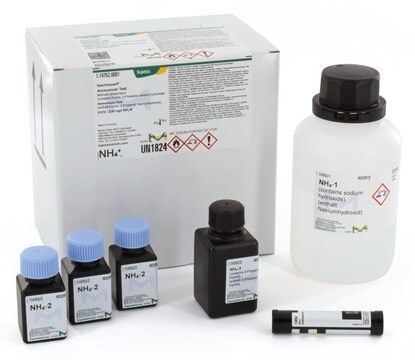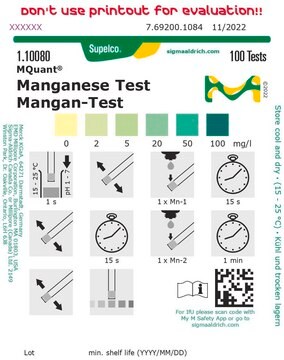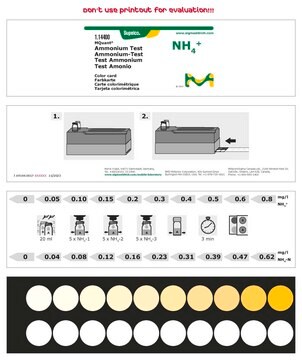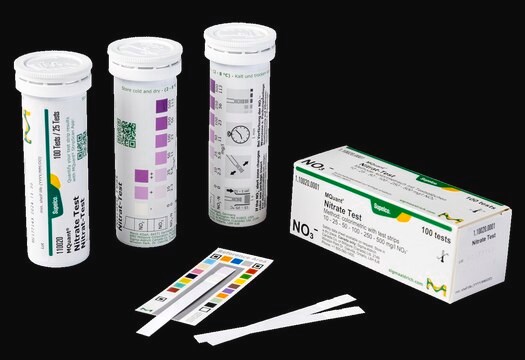1.14768
Manganese Test Kit, colorimetric
0.3-10 mg/L (Mn), MQuant®
Synonym(s):
Manganese Visual Test Kit
About This Item
Recommended Products
Product Name
Manganese Test, colorimetric, 0.3-10 mg/L (Mn), for use with MCOLORTEST®
specific analyte(s)
manganese
Quality Level
measuring range
0.3-10 mg/L (Mn)
compatibility
for use with MCOLORTEST®
detection method
colorimetric
storage temp.
15-25°C
General description
The test can be used in
- Groundwater and surface water, seawater
- Drinking water and mineral water
- Spring water and well water
- Boiler and boiler feed water, cooling water
- Wastewater and electroplating wastewater
- Nutrient solutions for fertilization
- Soils after appropriate sample pretreatment
Method
In alkaline solution manganese(II) ions react with an oxime to form a red-brown complex. The manganese concentration is measured semiquantitatively by visual comparison of the color of the measurement solution with the color fields of a color disk. The test evaluates the color reaction based on the transmitted light method. So even turbid and colored water samples can be analyzed without further preparation.
The color disk is made of very durable, lightfast plastic, thus suitable for industrial areas and wet environments.
Using the refill pack 1.18460 containing all the reagents, the original test kit can be used for a very long time, making it a particularly economical and ecological system.
Application
- An immobilized Schiff base-Mn complex as a hybrid magnetic nanocatalyst for green synthesis of biologically active [4,3-d]pyrido[1,2-a]pyrimidin-6-ones.: This study highlights the application of a manganese complex as a nanocatalyst in green chemistry. The manganese test is crucial in verifying the catalyst′s activity and stability, ensuring efficient synthesis of target compounds (Bodaghifard et al., 2024).
- Detoxification of vancomycin fermentation residue by hydrothermal treatment and pyrolysis: Chemical analysis and toxicity tests.: This research investigates the detoxification of fermentation residues, employing manganese tests to assess the residue′s chemical composition and potential environmental impact. The manganese test provides vital data for optimizing treatment processes (Zhang et al., 2024).
- Small-Molecule Fluorescent Probes for Binding- and Activity-Based Sensing of Redox-Active Biological Metals.: This review discusses advanced probes for detecting redox-active metals like manganese in biological systems. The manganese test is pivotal in validating these probes′ sensitivity and specificity, contributing to advancements in metal ion sensing (Grover et al., 2024).
- Associations of metals and metal mixtures with glucose homeostasis: A combined bibliometric and epidemiological study.: This study explores the correlation between metal exposure and glucose metabolism. The manganese test is employed to quantify manganese levels in biological samples, aiding in the identification of potential health risks (Li et al., 2024).
Legal Information
Signal Word
Danger
Hazard Statements
Precautionary Statements
Hazard Classifications
Aquatic Acute 1 - Aquatic Chronic 3 - Carc. 1B - Eye Dam. 1 - Met. Corr. 1 - Muta. 2 - Skin Corr. 1B - Skin Sens. 1 - STOT RE 2 Oral - STOT SE 3
Target Organs
Respiratory system, spleen
Storage Class Code
6.1C - Combustible, acute toxic Cat.3 / toxic compounds or compounds which causing chronic effects
WGK
WGK 3
Regulatory Listings
Regulatory Listings are mainly provided for chemical products. Only limited information can be provided here for non-chemical products. No entry means none of the components are listed. It is the user’s obligation to ensure the safe and legal use of the product.
PDSCL
Please refer to KIT Component information
PRTR
Please refer to KIT Component information
FSL
Please refer to KIT Component information
ISHL Indicated Name
Please refer to KIT Component information
ISHL Notified Names
Please refer to KIT Component information
Cartagena Act
Please refer to KIT Component information
JAN Code
キットコンポーネントの情報を参照してください
Certificates of Analysis (COA)
Search for Certificates of Analysis (COA) by entering the products Lot/Batch Number. Lot and Batch Numbers can be found on a product’s label following the words ‘Lot’ or ‘Batch’.
Already Own This Product?
Find documentation for the products that you have recently purchased in the Document Library.
Our team of scientists has experience in all areas of research including Life Science, Material Science, Chemical Synthesis, Chromatography, Analytical and many others.
Contact Technical Service